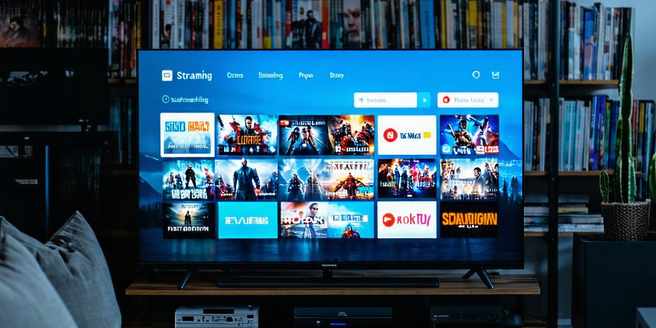Online Streaming Services

The Evolution of Online Streaming Platforms
The landscape of entertainment has been dramatically transformed by the rise of online streaming platforms. Initially, services like Netflix began as DVD rental solutions, but swiftly adapted to the digital age, pioneering a new model of instant, on-demand content. As broadband internet became prevalent, streaming platforms multiplied, offering vast libraries of films, TV shows, documentaries, and more, available anywhere with an internet connection. This evolution was driven by consumers’ desire for choice, convenience, and control over viewing schedules. Platforms like Hulu, Amazon Prime Video, and Disney+ have expanded the horizons of choice, enhancing user experiences with unique features like personalized recommendations and offline downloads. The competition among these platforms has led to diversified content offerings and innovative technological advancements, reshaping how audiences consume media globally.
Key Features of Popular Streaming Services
Online streaming services have redefined how consumers access and enjoy media, offering a wide array of features that cater to diverse preferences. Key among these are vast content libraries that span various genres and languages, providing viewers with a global selection of entertainment. User convenience is elevated through personalized recommendations powered by sophisticated algorithms that suggest content based on viewing habits. The ability to download content for offline viewing ensures accessibility even without an internet connection, while multi-device compatibility allows seamless streaming on phones, tablets, and smart TVs. Additionally, customizable parental controls offer peace of mind for families, ensuring suitable content access for children. The inclusion of original programming has also become synonymous with streaming services, drawing audiences with exclusive titles. These features collectively enhance user engagement and satisfaction, marking a shift in how media is consumed in the digital age.
Impact of Streaming on Traditional Media
The influence of streaming services has permeated the fabric of traditional media, precipitating considerable shifts in consumption patterns. Television networks, once dominant in the media industry, now face steep competition as audiences pivot towards on-demand platforms that offer greater flexibility and expansive content libraries. The decline in cable TV subscriptions, often referred to as ‘cord-cutting,’ underscores a preference for tailored viewing experiences, free from rigid broadcast schedules. Streaming’s rise has pushed traditional media to adapt, leading to the development of hybrid models like TV Everywhere, where viewers can access content online. Furthermore, the advertising landscape is shifting, with brands investing more in digitally native platforms to target audiences effectively. This transition poses challenges for traditional media but also paves the way for innovation, as industry players seek to blend conventional wisdom with modern streaming trends.
Subscription Costs and Value for Money
The competitive nature of the streaming industry has spurred diverse pricing strategies, influencing consumer perceptions of value. Subscription costs vary significantly, largely depending on content exclusivity, features, and geographic location. Platforms like Netflix, known for premium pricing, justify costs through a robust library and a commitment to high-quality originals. Conversely, services like Prime Video integrate additional benefits, such as free shipping, enhancing perceived value. Budget-conscious consumers often weigh the number of simultaneous streams, profiles, and whether ads are present against monthly fees. Bundling options, such as those offered by Disney+ with Hulu and ESPN+, offer value by combining varied content types under one subscription. Consumers are increasingly savvy, expecting more for their money and leveraging free trials, promotions, and comparative analysis to optimize their entertainment expense, making value for money a crucial battleground in subscriber retention.
The Role of Original Content in Streaming
Original content has emerged as a crucial differentiator in the hyper-competitive streaming market. With each platform vying for viewer attention, investing in unique and exclusive programming has become essential. Netflix set precedent with critically acclaimed originals like ‘Stranger Things’ and ‘The Crown,’ driving subscriber growth and brand loyalty. This strategy has been emulated across the industry, with Amazon’s ‘The Marvelous Mrs. Maisel’ and Disney+’s ‘The Mandalorian’ exemplifying how high-caliber productions captivate and retain audiences. Original content allows platforms to showcase creative storytelling, diversify offerings, and challenge traditional media conventions, often attracting prestigious awards and elevating the brand. Furthermore, it empowers platforms to cater to niche markets, embracing diverse narratives that resonate on a global scale. The strategic focus on originality not only enhances viewing experiences but also fortifies streaming platforms’ positions in an increasingly crowded digital landscape.
Future Trends in the Streaming Industry
The streaming industry is poised for continuous evolution as technological advancements and consumer preferences shape its trajectory. One prominent trend is the rise of niche platforms catering to specific interests, tapping into communities with targeted content. The integration of augmented and virtual reality technologies promises to enhance immersive viewing experiences. Moreover, AI-driven personalization is set to become more sophisticated, offering hyper-curated content recommendations. As the industry matures, consolidation may occur, with mergers and acquisitions further streamlining content offerings. Simultaneously, live streaming, particularly in sports and events, is gaining traction as platforms seek to diversify beyond traditional on-demand content. Global expansion remains a priority, with localization efforts ensuring broader accessibility. As competition intensifies, platforms will continue experimenting with pricing models, ad-supported tiers, and interactive content, ultimately striving to redefine the boundaries of digital entertainment. These trends underscore a dynamic future for the streaming landscape.